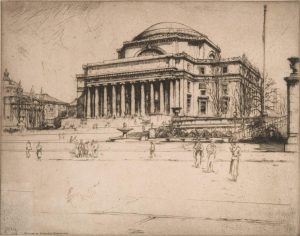
Library of Columbia University, New York, Photo Credit: New York Historical Society
You are a typical Columbia College undergraduate student. CDC guidelines permitting, in your first year you live and breathe Columbia’s neoclassical (or Beaux-Arts, depending on who you ask) -style campus; and as far as academics go, the Core is all you can be certain about. You begin the year with a copy of Homer’s Odyssey in hand. For a week or two, you lug this book from the southernmost edge of campus, where you live, to—in all likelihood—Hamilton Hall, a couple hundred feet from your door, and back. Four or more times a week, you pass two stained glass windows depicting Sophocles and Virgil (gifts of the classes of 1885 and 1891, respectively) whose works will soon replace the Odyssey in your bag. In your second year, you may live as far away as Carlton Arms on Riverside, between 108th and 109th; you face the prospect (as I did) of ferrying your copy of Kant’s Critique of Pure Reason as far as Riverside Church on 120th and, on your very first day of the spring semester, gambling on which grand, pointed arch to duck into to escape the doom and gloom of winter.
It occurs to you that in a lot of ways, the bare essentials of your life belong to the late 19th and early 20th centuries: the buildings where you live, eat, and attend class; the mainstays of the neighborhood—The Cathedral of St. John the Divine, Mount Sinai Hospital, Morningside Park, Riverside Park. And above all, the greater part of your education, whose Core emerged as a spin on the school’s World War I-era “war issues” course and took shape more in the image of the school’s old classics-oriented studia humanitatis model than its competitor, the vocationally-oriented German Gymnasium.
So why not dress the part? A lot of other students are, you notice—administrators and instructors to boot. Argyle and vintage abound, and on any given winter day, long, wool coats aren’t unlikely to beat out puffers and parkas. You think you might’ve seen a pince-nez or two around, and can swear to having seen one or two bow ties worn, along with several ascots, a handful of knotted scarves and, however anachronistic, a few cravats.
You begin to feel some tension between your day-to-day life and your noticeably 21st-century wardrobe. You swap your white sneakers for Oxfords and exchange your puffer for a peacoat. You admit to yourself that standing out is distressing. There’s something deeply discomfiting about disrupting the integrity, and most conspicuously the aesthetic integrity, of a space, its institutions and communities—or, when that sense of integrity fails to sustain itself, what you think that space wants to be. The more time you spend in a space, the more urgent it is that this sense of discomfort be extinguished, especially if that space means something to you. Even to a complete cynic, you think, there must surely be some value to associating yourself in dress, in speech, or in action with a history, an institution or a tradition which has been so successfully canonized, and which carries such capital. So why not dress in pastiche? To do so seemed out of touch to you at first, a sign of excess nostalgia, even a naive escape from the more proximal—and therefore less easily romanticized—problems of the present day. These concerns haven’t left you, but you’re interested now in testing your faith in the College, the Core. You won’t accept anything less than complete immersion.
What better way to understand the past and its limits, your limited access to it and the limits of its hold on you, than to cosplay it, to live it and make it real? How will you speak? How will you walk? How will you find pince-nez in your prescription? Haunted by the ghosts of the past, their triumphs and their crimes, you search for answers in Butler’s facade. Where else? You read: Homer, Herodotes, Sophocles, Plato; Goethe, Voltaire, Milton, Shakespeare. You sit and think for a long time. You’ll have to take some liberties, you decide. You’re a student, sure, but all the world’s a stage. So at this College, taking the Core, you’re no less than—and this shocks you, at first—a method actor.
